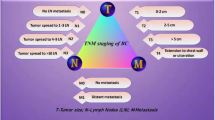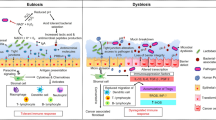Abstract
Deregulation of oncogenes and tumor suppressor genes involved in apoptosis has been associated with tumor development and progression. To investigate the involvement of apoptosis regulating proteins in oral cancer in Indian patients, primarily associated with chewing tobacco habits, immunohistochemical expression of bcl-2 and bax was examined in 63 oral squamous cell carcinomas, and 31 putative premalignant lesions. Our studies revealed overexpression of tumor specific cytoplasmic bcl-2 in 56% and bax in 43% oral cancers. The oral cancers in the Indian patients are preceded by premalignant oral lesions; hence oral lesions were examined for bcl-2 and bax expression. We observed aberrant expression of bcl-2 in 16% oral lesions comprising leukoplakias and SMF and bax in 55% oral lesions. We have already reported, p53 expression in these oral cancers and lesions. It was noteworthy that 30% oral cancers demonstrated a p53+bcl2+ pattern, and 14% samples exhibited p53+bcl2+bax+ pattern. However, none of the oral lesions showed concurrent deregulation of p53 and bcl-2 or all the three genes. Interestingly 45% oral lesions were p53-bax+ as compared to 18% oral cancers; while 39% oral lesions were bcl2-bax+ as compared to 14% oral cancers, indicating overexpression of bax in oral lesions, in the absence of p53 and bcl-2 proteins. Significant correlation was observed between positive nodal status and bcl2+ (p=0.047) and p53+bcl-2+ (p=0.01) in oral cancers. Kaplan Meier survival analysis showed significantly (p=0.059) higher survival in patients with p53-oral tumors than with p53+ tumors. Our studies thus indicate frequent overexpression of apoptosis regulators bcl-2, bax and p53 proteins in oral cancers, and a subset of oral lesions, representing early events in oral carcinogenesis. The aberrant bcl-2 expression and loss of p53 function observed, may play an important role in the tumorigenesis of oral cancers by allowing escape from apoptosis and enabling additional genetic alterations to accrue.
Similar content being viewed by others
References
Moore SR, Johnson NW, Pierce AM, Wilson DF: The epidemiology of mouth cancer: a review of global incidence. Oral Diseases 6:65–74, 2000.
National Cancer Registry Programme: Consolidated Report of the Population Based Cancer Registries : 1990–1996, Incidence and Distribution of Cancer under the ICMR, New Delhi, August 2001.
Gupta PC, Bhonsle RB, Murti PR, et al: An epidemiological assessment of cancer risk of oral precancerous lesions in India with special reference to nodular leukoplakia. Cancer 63:2247–2251, 1989.
Tradati N, Grigolat R, Calabrase L, et al: Oral leukoplakia to treat or not? Oral Oncol 33:317–321, 1997.
Saranath D, Panchal RG, Nair R, et al. Oncogene amplification in squamous cell carcinoma of the oral cavity. Jpn J Cancer 80:430–437, 1989.
Saranath D, Panchal RG, Nair R, et al. Amplification and overexpression of epidermal growth factor receptor in human oropharyngeal cancer. Eur J Cancer B Oral Oncol. 28:139–143, 1992.
Saranath D, Chang SE, Bhoite LT, et al: High frequency mutation in codon 12 and 61 of H-ras oncogene in chewing tobacco related human oral carcinomas in India. Br J Cancer 63:573–578, 1991.
Saranath D, Bhoite LT, Mehta AR, et al: Loss of allelic heterozygosity at the Harvey locus in human oral carcinomas. J Cancer Res Clin Oncol. 117:483–488, 1991.
Saranath D, Bhoite LT andDeo MG: Molecular lesions in human oral cancer: the Indian scene. Eur J Cancer Oral Oncol. 29:107–112, 1993.
Tandle A and Saranath D. Genetic alterations on chromosome 3, p53 tumor suppressor gene and telomerase activity in oral cancers from India. Asian Pacific Journal of Cancer Prevention, Vol. I APCC Supplement 219–225, 2000.
Mahale A andSaranath D: Microsatellite alterations on chromosome 9 in chewing tobacco-induced oral cell carcinomas from India. Oral Oncol 36:199–206, 2000.
Saranath D, Tandle AT andDeo MG: Loss of p53 gene as a biomarker of high risk oral leukoplakia. Indian J Biochem Biophy 34:266–273, 1997.
Saranath D, Tandle AT Teni TR, et al: p53 inactivation in chewing tobacco-induced oral cancers and leukoplakias from India. Oral Oncol. 35:242–250, 1999.
Field JK, Spandidos DA andStell PM. Overexpression of the p53 gene in head and neck cancer, linked with heavy smoking and drinking. Lancet 339:502–503, 1992.
Miyashita T, Krajewski S, Krajweska M, et al: Tumor suppressor p53 is a regulator of bcl2 and bax expression in vitro and in vivo. Oncogene 9:1799–1805, 1994.
Wing Y, Szekely L, Okan J, Klien G et al: Wild type p53 triggered apoptosis is inhibited by bcl2 in v-myc induced T-cell lymphoma lines. Oncogene 8:3427–3431, 1993.
Pollina L, Pacini F, Fontanini G et al: Bcl2, p53 and proliferating cell nuclear antigen expression is related to the degree of differentiation in thyroid carcinomas. Br J Cancer 73:139–143, 1996.
Qi-Lung, Abel P, Foster CB, et al: Bcl-2: Role in epithelial differentiation and oncogenesis. Human Pathol. 27:102–109, 1996.
Jordan RCK, Catzavelos GC, Barrett AW, et al: Differential expression of bcl2 and bax in squamous cell carcinomas of the oral cavity. Oral Oncol. 32B:394–400, 1996.
Stoll C, Baretton G, Abrens C, et al: Prognostic significance of apoptosis and associated factors in oral squamous cell carcinoma. Virchows Arch 436:102–108, 2000.
Birchall MA, Schock E, Harmon BV et al: Apoptosis, Mitosis, PCNA and bcl2 in normal, leukoplakic and malignant epithelia of the human oral cavity: prospective, in-vivo study. Oral Oncol 3:419–425, 1997.
Pena J, Thompson CB, Recant W, et al: Bcl-xL and Bcl2 expression in squamous cell carcinoma of head and neck. Cancer 85:164–170, 1999.
Yao L, Iwai M andFuruta I: Correlation of bcl2 and p53 expression with the clinico pathological features in tongue squamous cell carcinomas. Oral Oncol. 35:56–62, 1999.
Ravi D, Ramadas K, Mathew BS, et al: De novo programmed cell death in oral cancer. Histopathol. 14:241–249, 1999.
Kannan K, Lakshmi Latha PN andShanmugan G etal: Expression of bcl2 oncoprotein in Indian oral squamous cell carcinomas. Oral Oncol 34:373–377, 1998.
McAlinden RL, Maxwell P, Napiet S, et al: Bcl-2 expression in sequential biopsies of potentially malignant oral mucosal lesions assessed by immunocytochemistry. Oral Diseases 6:318–326, 2000.
Author information
Authors and Affiliations
Corresponding author
Rights and permissions
About this article
Cite this article
Teni, T., Pawar, S., Sanghvi, V. et al. Expression of bcl-2 and bax in chewing tobacco-induced oral cancers and oral lesions from India. Pathol. Oncol. Res. 8, 109–114 (2002). https://doi.org/10.1007/BF03033719
Received:
Accepted:
Issue Date:
DOI: https://doi.org/10.1007/BF03033719




